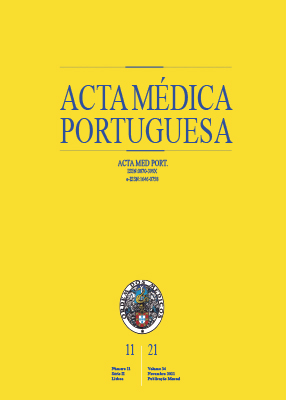Urinary Incontinence in Women Who Practice Recreational Exercise: A Cross-Sectional Study
DOI:
https://doi.org/10.20344/amp.14004Keywords:
Exercise, Sports, Urinary IncontinenceAbstract
Introduction: Urinary incontinence affects up to one third of women in Portugal. Exercise can be a precipitating/aggravating factor but also protective, if appropriate. The aim of this study was to determine the prevalence of urinary incontinence in women who practice recreational exercise, to assess its relationship with the type of exercise and other coexisting risk factors, and assess whether the topic is addressed in gyms.
Material and Methods: Cross-sectional study using self-reported questionnaires in gyms in Porto and Vila Nova de Gaia, Portugal.
Results: Two hundred and ninety women completed the questionnaires. From these, 67.6% were under 40 years old, 25.2% reported incontinence, and 53.4% had at least one risk factor unrelated to exercise. There was a statistically significant association (p < 0.05) between incontinence, obesity and constipation. High impact exercises were included in the training of 62.1% continent and 50.9% incontinent women. The topic of incontinence and strengthening of the pelvic floor muscles was addressed in only 5.5% in the initial assessment, 9.7% in collective training, and in 13.5% of the 37 women with individualized training.
Discussion: The higher proportion of continent women - compared to incontinent - who practiced strenuous exercise suggests that this might be a provocative factor for some, although there was no statistically significant association between incontinence and type of exercise.
Conclusion: Urinary incontinence affects women who practice recreational exercise, regardless of age and exercise characteristics. It is rarely addressed in gyms, and it is necessary to raise the awareness of professionals to enhance the preventive/therapeutic effects of exercise on the function of the pelvic floor and in the control of modifiable risk factors.
Downloads
Downloads
Published
How to Cite
Issue
Section
License
Copyright (c) 2021 Acta Médica Portuguesa

This work is licensed under a Creative Commons Attribution-NonCommercial 4.0 International License.
All the articles published in the AMP are open access and comply with the requirements of funding agencies or academic institutions. The AMP is governed by the terms of the Creative Commons ‘Attribution – Non-Commercial Use - (CC-BY-NC)’ license, regarding the use by third parties.
It is the author’s responsibility to obtain approval for the reproduction of figures, tables, etc. from other publications.
Upon acceptance of an article for publication, the authors will be asked to complete the ICMJE “Copyright Liability and Copyright Sharing Statement “(http://www.actamedicaportuguesa.com/info/AMP-NormasPublicacao.pdf) and the “Declaration of Potential Conflicts of Interest” (http:// www.icmje.org/conflicts-of-interest). An e-mail will be sent to the corresponding author to acknowledge receipt of the manuscript.
After publication, the authors are authorised to make their articles available in repositories of their institutions of origin, as long as they always mention where they were published and according to the Creative Commons license.









